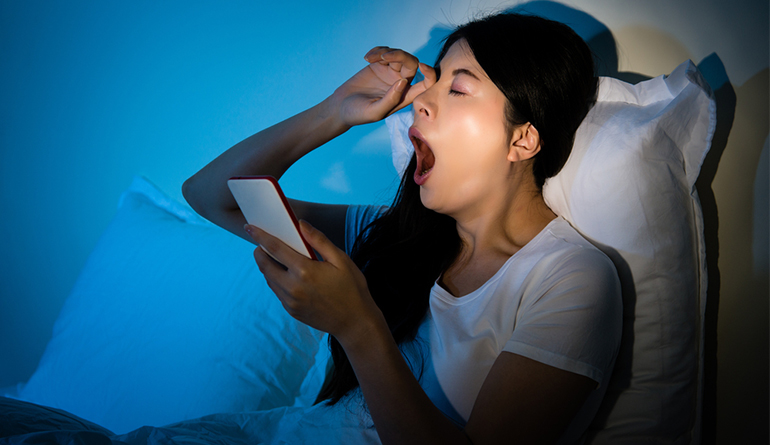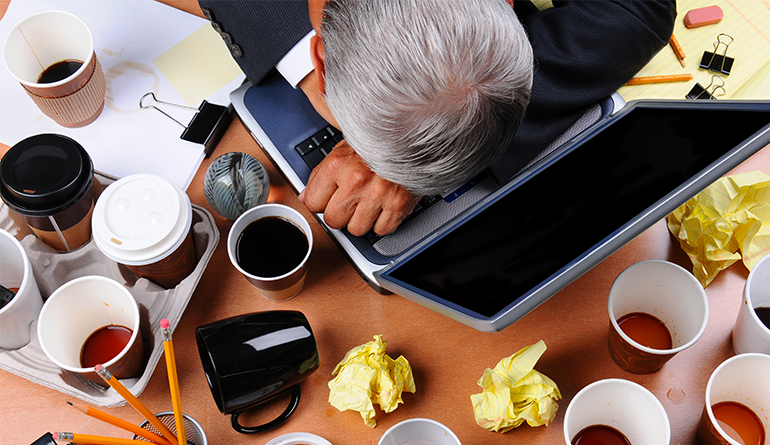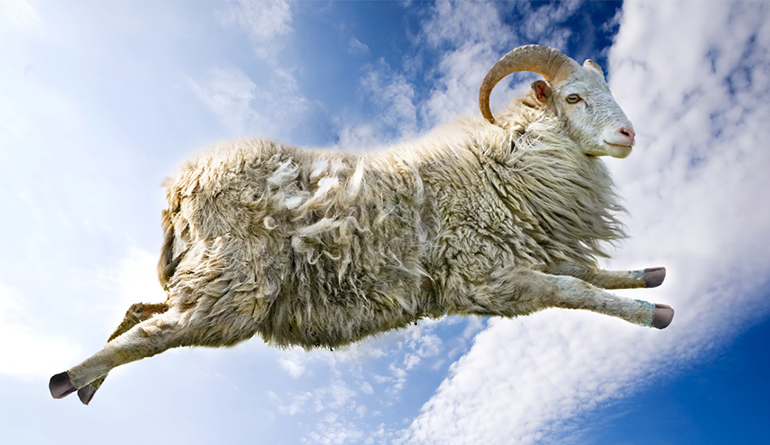Catching up on Z’s after a busy, sleepless week? We hate to be the bearer of bad news, but making up for lost snooze time is impossible. This, along with countless other misconceptions about sleep, might be taking a toll on your health and well-being.
Stifle that yawn and read on… We’re debunking 30 common sleep myths to help you rest easier tonight.
Myth #1: A weekend sleep-in or siesta will erase those sleepless nights
As mentioned previously, snoozing extra on the weekends doesn’t make up for lost time. According to bettersleep.org, banking sleep is just as ineffective.
Truth: For optimal mental and physical health, get adequate sleep throughout the week. If you’re craving a weekend nap, opt to doze early in the day to avoid yet another sleepless night.
Myth #2: People need 8 hours of sleep each night, regardless of age
If you wake up feeling less than refreshed, you might be sleeping too much or too little. Sleep isn’t one size fits all, and the longstanding 8-hour “rule” doesn’t apply to everyone.
Truth: Our sleep needs change as we grow and age, with school age children needing 9 to 11 hours of shuteye, and adults needing 7 to 9 hours. Older adults (65+) need just 7 to 8 hours, according to recent research. Finding your sleep sweet spot might take some time, but the trial and error period is well worth the well-rested rewards.
Myth #3: Struggling to stay awake during the day = a need for more sleep
Many people assume that daytime exhaustion is the result of poor sleep at night. While this can be the case, daytime sleepiness can be a sign of an underlying health problem.
Truth: Daytime tiredness can occur even after a good night’s sleep, according to sleepfoundation.org. Folks who have trouble staying awake could be suffering from sleep apnea or narcolepsy, and should contact a healthcare professional. Proper treatment can lead to a more fulfilling life by decreasing daytime exhaustion.
Myth #4: Insomnia is the inability to fall asleep
Okay, you caught us. Insomnia can indeed make it difficult to fall asleep. However, insomnia is so much more; it can affect us in the middle of the night and even in the morning.
Truth: While insomnia can keep us from falling asleep, it can also mean waking too early, the inability to get back to sleep after waking, waking frequently, and/or waking up groggy. If you’re suffering with insomnia, establish a nighttime ritual, and contact your physician if sleep problems persist.
Myth #5: The brain takes a break during sleep
If you’ve ever crawled into bed and your mind began to race, you’ve probably already debunked this popular myth. It’s just as important for our brains to be alert at night as it is throughout the day.
Truth: The brain works round the clock to ensure our internal systems are always in working order. Webmd.com explains that the brain recharges itself as we sleep, even though it remains active.
Myth #6: Count sheep to fall asleep
Have you ever been successful falling asleep after counting a flock of sheep? We didn’t think so. As it turns out, counting the wooly creatures can actually prolong the process.
Truth: A study by Oxford University found that imagery can be helpful for distraction. Rather than counting sheep, picture yourself on a sandy beach or in another soothing place. This visualization will take your mind off any worries or next day to-do’s.
Myth #7: Sore backs need firm mattresses
Softer mattresses get a bad rap despite their popularity. A firmer option isn’t necessarily the best option for folks with back pain, despite this age-old myth.
Truth: Yes, firm mattresses serve a purpose and are often recommended, but according to bettersleep.org, choosing a mattress is a matter of personal choice, and the mattress that works for one person won’t always work for another.
Tip: Many people opt to spend $1000s on changing their mattress. If you suffer from back pain, we suggest changing your pillow first to one more fitting to your mattress density. For more advice on the best pillows for back pain, follow the link.
Myth #8: Sleep and health issues are separate concerns
Our body’s systems are all working in conjunction, so it doesn’t make sense that our sleep quality wouldn’t impact our health, and vice versa.
Truth: Poor sleep has been linked to many health conditions, including hypertension, cardiovascular issues, and lowered metabolism, according to the Cleveland Clinic. When visiting your physician, be sure to inquire about any health concerns that may be linked to insomnia or other sleep problems.
Myth #9: People are either night owls or early birds
Are you a morning person or do you prefer staying up late? The body’s circadian rhythms predetermine variances in alertness during the day, so your preference for rising or snuggling in early might simply be a habit.
Truth: Our energy level naturally ebbs and flows throughout the day; when nighttime comes, we become sleepier by nature.
Tip: Have an early start tomorrow and need to hit the hay earlier tonight? Turn off any blue-emitting LED lights and digital devices and cozy up with a book and candle. Even artificial light can keep us wired, research shows.
Myth #10: The snooze button is your friend
When you snooze, you lose. Unfortunately, the snooze button isn’t your friend. Even if you get a few extra winks, waking up repeatedly to annoying beeps cancels out any benefits.
Truth: Scientists have found that hitting snooze is counterproductive. According to lifehacker.com, our brains begin stage one of the sleep cycle when we attempt to go back to dreamland. “When the alarm goes off a second time, you’re likely at an even deeper, earlier part of your sleep cycle, which results in you feeling even worse than you did the first time,” the site explains.
Myth #11: If you get up, you’ll be up all night
Can’t sleep? Lying in bed might prolong your insomnia. Sometimes it’s best to get up and take part in a relaxing activity rather than trying to force it.
Truth: If you’re unable to sleep after visualizing a peaceful place, go to another room in your home. Listen to music, drink a cup of warm tea, or read until you begin to feel sleepy.
Tip: Refrain from using digital devices, including the television. The blue-emitting light will trick your body into thinking it’s daytime and keep you wide awake.
Myth #12: Snoring is normal
Sure, lots of people snore, but that doesn’t mean it’s not a symptom of an underlying health problem. Snoring is often a sign of sleep apnea, and has also been linked to hypertension, according to the Cleveland Clinic.
Truth: It’s important to contact a healthcare provider if you snore regularly and are tired throughout the day. Sleep apnea can lead to major health problems, including cardiovascular disease. Don’t fret if you’re a chronic snorer… Sleep apnea is treatable.
Myth #13: Long naps are rejuvenating
If you love a long nap but wake up exhausted, your sleep duration could be to blame. Waking up in the middle of a sleep cycle can lead to grogginess and decreased energy.
Truth: A nap can be refreshing, but the key is to keep it short. Aim for a 20-minute siesta early in the day to reap the benefits – or even try a coffee nap!
Myth #14: Alcohol is a sleep aid
Many people use alcoholic beverages to lull themselves to sleep. Unfortunately, alcohol consumption doesn’t work long-term… or even through the night.
Truth: When alcohol wears off, our minds become more alert. Sleep expert Dr. Nitun Verma explained to lifehacker.com that alcohol disrupts sleep by interfering with the REM stage. This disruption throws off other sleep cycles, making for a restless night… and difficult morning.
Myth #15: Box springs aren’t important
On average, mattresses should be replaced every seven years, but most folks bow out when it comes to replacing the box spring.
Truth: Box springs break down over time—just like mattresses—and need to be replaced regularly.
Tip: When you go mattress shopping, ask for deals on mattress and box spring sets.
Myth #16: Sleeping pills don’t have a long-lasting effect
It might seem harmless to take a pill or two to initiate sleep at night. Sadly, these medications are causing life-altering health problems—and worse.
Truth: Studies are finding that patients who rely on hypnotics are at an increased risk of cancer and death. And it’s not just those individuals who take pills on a nightly basis… People taking less than 18 pills per year were affected, one study showed.
Myth #17: Eating cheese causes nightmares
For decades, noshing on cheese before bed has been linked to terrifying nightmares. Since Charles Dickens’ A Christmas Carol was released in 1938, folks have been haunted by Ebenezer Scrooge’s food-induced bad dreams.
Truth: There is no scientific research proving that cheese leads to nightmares. One small study by the British Cheese Board, however, concluded that snacking on cheese before bed can lead to “crazy, vivid dreams.” Perhaps the savory treat should be saved for daytime snacks.
Myth #18: Loud music will keep you awake while driving
Many men and women believe a blast of cold air and blaringly loud tunes will keep them awake when driving. Unfortunately, air conditioning and music don’t stave off sleepiness.
Truth: More than half of Americans have admitted to driving while tired. It’s no surprise then that there are 100,000 police-reported automobile accidents linked to driver fatigue every year.
Tip: If you’re driving on empty, stop for a power nap and/or drink coffee or another caffeinated beverage.
Myth #19: Yawning means you’re tired
Can’t stop yawning during a boring business meeting? Sadly, science has no idea why. But chances are your stifled yawns aren’t a sign of exhaustion.
Truth: Yawning is a phenomenon. That’s right… Scientists continue to delve into the reason we yawn and continue to come up short on explanations. Some folks believe that low oxygen in the lungs is to blame, but this theory has been debunked. To add to the mystery, yawns seem to be contagious (and no one knows why).
Myth #20: Evening exercise helps sleep
There’s no doubt that physical activity is good for physical and mental well-being. There is, however, an ongoing debate when it comes to evening exercise.
Truth: Movement is often energizing, so it’s best to exercise earlier in the day. As far as sleep quality, one study showed that the time of day a person exercises has no effect on slumber. Yet one study concluded that a whopping 150 minutes of moderate weekly exercise improved sleep quality.
Myth #21: Natural sleep aids are safe for anyone
Rather than visiting the doctor, many men and women attempt to self-diagnose and treat their sleep issues. But even natural drug alternatives can lead to health complications.
Truth: Natural remedies, such as valerian root, are regularly used as sedatives. Another, kava kava, has been linked to muscle and kidney problems. Natural alternatives can also negatively interact with prescription and over-the-counter medications. Check with your doctor before taking any drug or natural substitutions.
Note: The use of over-the-counter sleep aids can also be harmful. Consult a healthcare professional before stopping by the drug store.
Myth #22: Night terrors and nightmares are one and the same
Many children—and some adults—struggle with night terrors, which cause them to wake in a state of terror or panic. Many people believe these terrors are simply nightmares.
Truth: Night terrors are unique from nightmares, which can often be recalled the next morning. Luckily, children typically outgrow night terrors by adolescence.
Myth #23: Thanksgiving turkey causes drowsiness
If you’re like most people, you blame your turkey day tiredness on the bird. Most folks report a lack of energy and urge to snooze after eating turkey.
Truth: There is actually no more tryptophan in turkey than there is in other poultry, including chicken. The energy lull you feel might be a combination of factors; our circadian rhythms naturally dip in the afternoon hours, which is one viable explanation.
Myth #24: Startling a sleepwalker can kill them
Over the years, people have been terrified to awaken sleepwalkers. It’s believed that startling a sleepwalking person could startle them into a heart attack and/or even death.
Truth: Sure, waking up a sleepwalker might temporarily scare them, but there is no documented evidence that waking them up causes death.
Myth #25: Rest replaces sleep
It might seem like relaxing in bed would be just as rejuvenating as sleeping. In truth, our bodies need deep sleep in order to function properly during our waking hours.
Truth: Sleep expert Stephen Scharf told Van Winkle’s that “sleeping is a different state of being than resting.” He added: “During sleep, there are a number of neurologic and reconstructive processes that don’t go on during the wake state.”
Myth #26: Some people just don’t dream
People who don’t recall their dreams often believe they don’t dream at all.
Truth: Everyone dreams, even those individuals who don’t remember their dreams the next morning, The Better Sleep Council reports.
Myth #27: Milk will make you drowsy
Drinking warm milk before bed is believed to cause relaxation and lead to better sleep.
Truth: While there’s no scientific proof that milk will make you sleepy, a warm beverage before bed as part of a bedtime routine can be comforting and relaxing.
Myth #28: You can be arrested for removing a mattress tag
For years, many men and women have believed that removing the tag from their mattress is illegal.
Truth: There’s no need to worry… Removing your mattress tag is completely legal after purchase. Removing the tag before you become you own the mattress is a different story…
Myth #29: We swallow spiders during sleep
In 1993, writer Lisa Holst published a column to prove how gullible people are. In the article, Holst included a false statistic stating that people swallow an average of eight spiders per year in their sleep.
Truth: Spiders avoid humans; the creepy crawlers sense danger from human vibrations, according to scientificamerican.com. Plus, why would spiders waste their time exploring the human body when they have prey to catch?
Myth #30: Adults can train themselves to function on less sleep
Many men and women believe they need less sleep than is recommended to function properly. The vast majority of people, however, can’t thrive on little sleep.
Truth: Adults build up sleep debt when they skimp on sleep. Getting less than the recommended amount can also lead to slower reaction times, increased accidents and mistakes, irritability and anger.
Tip: Get the recommended amount of sleep each night for a healthier, happier you.
Resources:
http://bettersleep.org/better-sleep/sleep-myths/
https://sleepfoundation.org/excessivesleepiness/content/how-much-sleep-do-we-really-need-0
https://sleepfoundation.org/how-sleep-works/myths-and-facts-about-sleep/page/0/1
https://www.webmd.com/sleep-disorders/sleep-fact-fiction#1
https://www.ncbi.nlm.nih.gov/pubmed/11863237
https://my.clevelandclinic.org/health/articles/12141-myths-and-facts-about-sleep
http://www.pnas.org/content/112/4/1232
https://lifehacker.com/5991618/science-explains-why-you-should-stop-hitting-the-snooze-button
https://lifehacker.com/nix-the-nightcap-how-alcohol-and-marijuana-can-harm-yo-1740024287
http://bmjopen.bmj.com/content/2/1/e000850
https://www.sciencealert.com/does-eating-cheese-before-bed-give-you-nightmares
https://sleepjunkies.com/society/drowsy-driving-questions-answers/
https://digitalcommons.wayne.edu/oa_theses/119/
https://www.webmd.com/food-recipes/features/the-truth-about-tryptophan#1
https://www.scientificamerican.com/article/waking-a-sleepwalker-may-kill-them/
https://vanwinkles.com/nine-myths-about-sleep-that-arent-true
https://sleephealthfoundation.org.au/files/pdfs/Sleep-Myths.pdf




